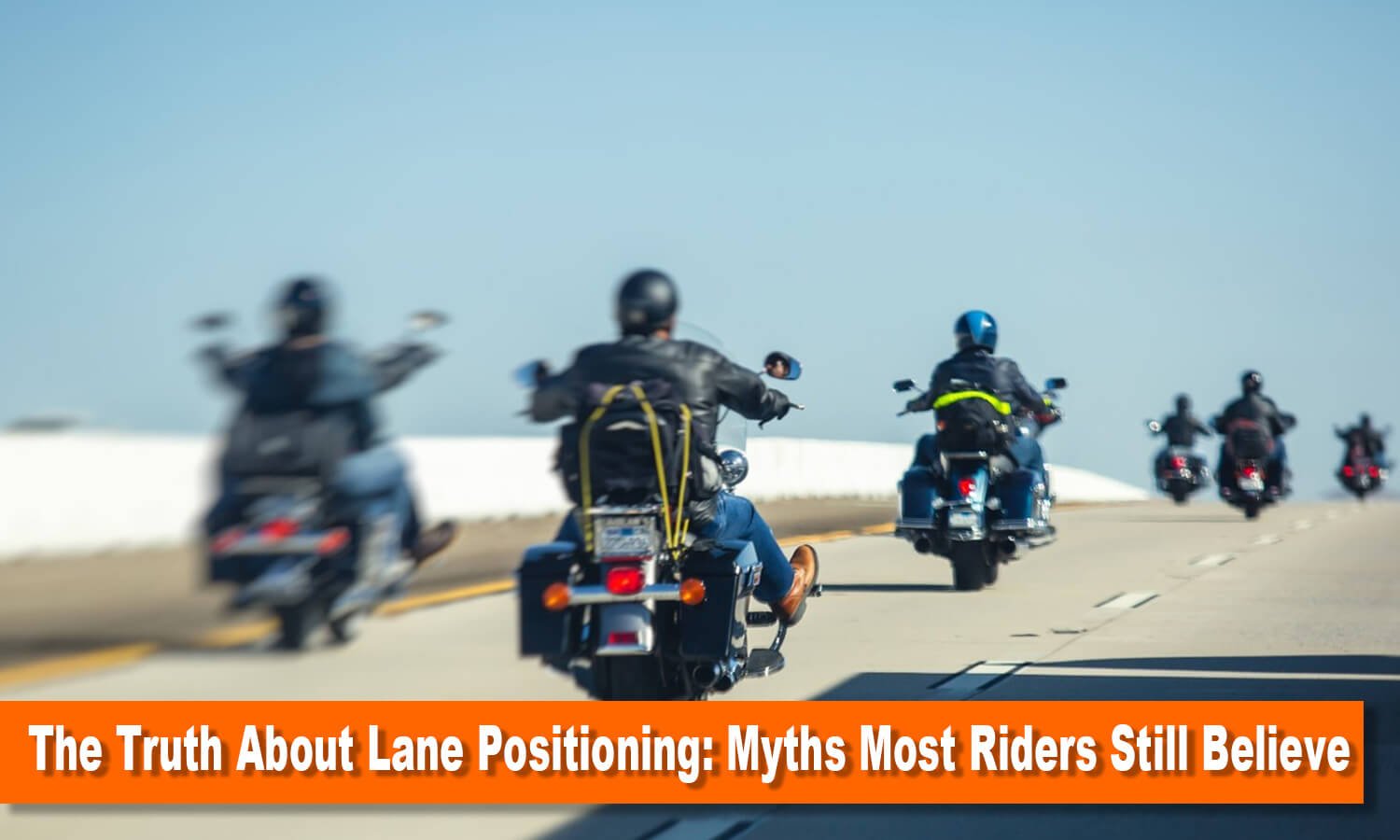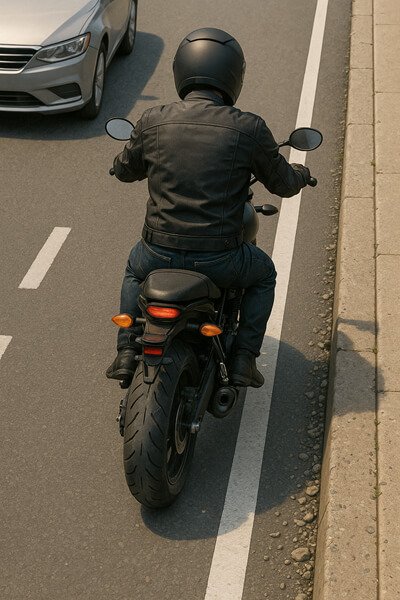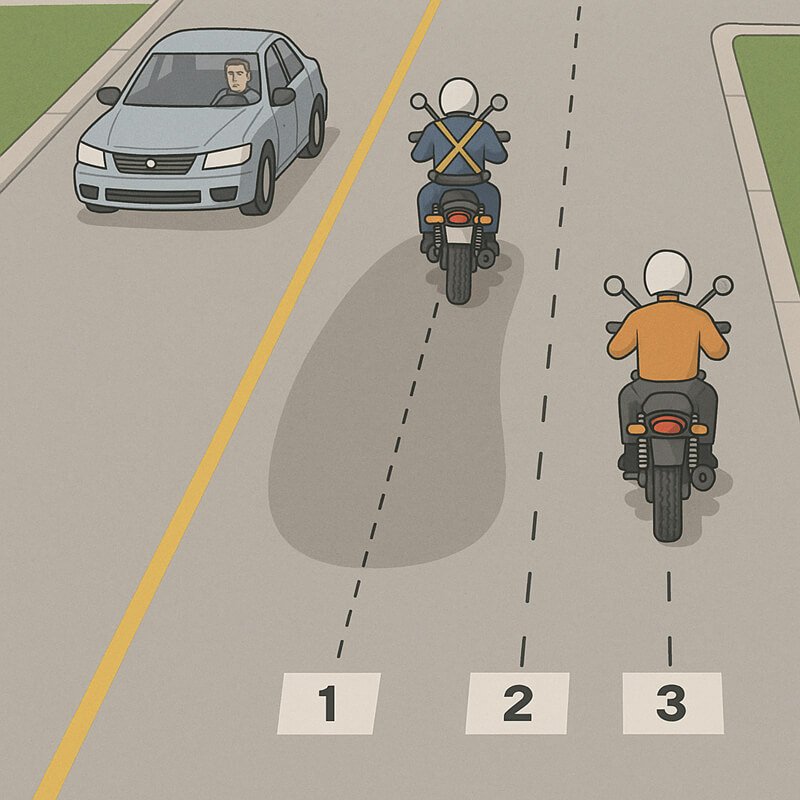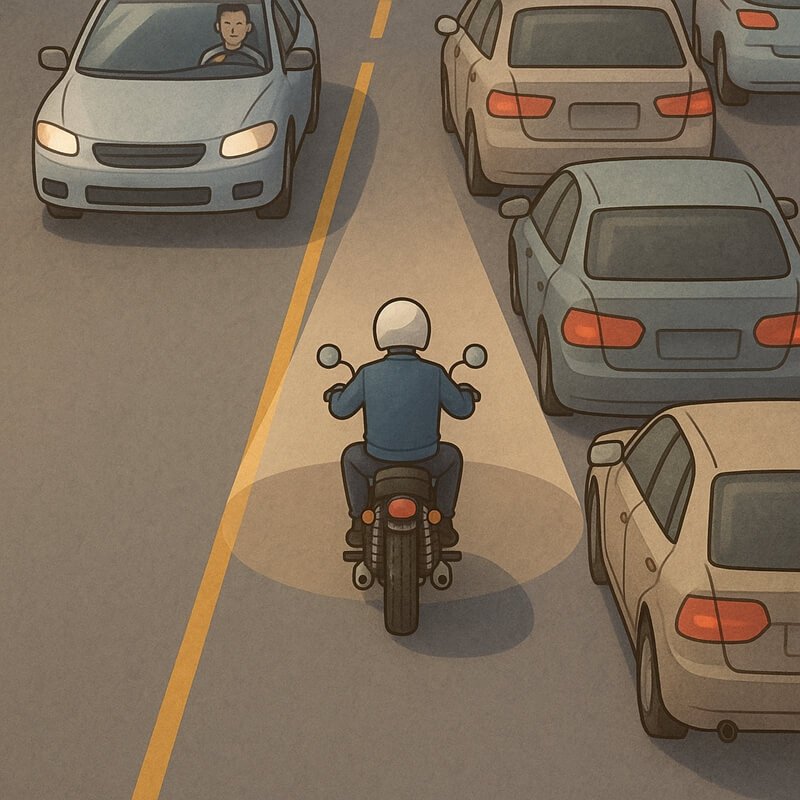If you're looking for a new motorcycle intercom system this year, Fodsports has something exciting in store. The company has launched two new Bluetooth helmet intercoms: T1 and T1 Pro. Both models bring upgraded features, sleek design, and high-definition audio quality for riders who want to stay connected, entertained, and safe on the road. But […]

The Truth About Motorcycle Lane Positioning: Myths Most Riders Still Believe
When it comes to motorcycle safety, lane positioning is a key topic that many people don't grasp. A lot of riders think the safest bet is to always stick to the right side of the lane. They believe this "keeps an escape route open." But this simple view can create dangerous situations and make riders miss chances to see better and stay safer.
In this article, we'll debunk common myths about motorcycle lane positioning and explain the right way to do it using the newest riding safety findings. You'll discover how to use lane positioning in a smart active way to make your rides safer and more fun.
Table of Contents
The Common Myth: Always Ride on the Right Side of the Lane

Always ride on the right side of the lane
Many riders have been taught or assume that riding as far right as possible in your lane is the best way to keep “an escape route” open on your left. The logic is simple: if something goes wrong, you can quickly swerve left into open space.
While this sounds reasonable at first glance, it is not always true — and sometimes it can put you in greater danger. Riding only on the right side may:
- Put you in the blind spot of other vehicles.
- Bring you closer to hazards like road debris, gravel, or potholes often found near the curb or shoulder.
- Reduce your visibility to cars approaching from behind or at intersections.
- Limit your options for quick evasive action in some scenarios.
The truth is, lane positioning on motorcycle is dynamic, and a rider should be ready to move within the lane depending on multiple factors.
Motorcycle Lane Position 1 2 3: The Three Lane Position Strategy
A helpful mental model is to break the lane into three zones:
- Position 1 (Left third): Closest to the centerline or yellow line
- Position 2 (Center third): In the middle of the lane
- Position 3 (Right third): Closest to the road edge or shoulder

The three lane position strategy
Each position has its advantages. Use them like tools in your toolbox.
Position 1 (Left Side of Lane)
When to use:
- Left turns & Oncoming Traffic: Approach intersections or curves and shift left so drivers see you before turning.
- Parked cars on your right: Give a car door’s width to parked vehicles (don’t ride too close to them). This often means riding in the left third to avoid being “doored.”
- High visibility: In dense traffic, leftmost position makes you more visible to oncoming drivers and those ahead.
- Blocking lane: Sometimes used proactively to discourage cars from crowding your lane (e.g. in slow traffic).

blocking lane
Why it helps:
- Maximizes visibility. Cars ahead and oncoming traffic are more likely to spot you.
- Avoids blind spots. You stay out of many drivers’ sideview blind spots by moving away from the center of their vehicles.
- Better sight lines. In right-hand curves or intersections, Position 1 gives you a better view of the road ahead.
Watch out:
- Oncoming vehicles: Riding too close to the center line can be dangerous if a driver drifts across. Keep an eye on oncoming traffic and widen your gap if needed.
- Not too far left: On multi-lane roads, hogging the left might confuse others (a car might think you’re turning left). Only shift fully left when you intend to pass or turn.
- Narrow roads: If the lane is very narrow, hugging the centerline can be risky—adjust as needed.
Position 2 (Center of Lane)
When to use:
- Balanced spacing: If vehicles or hazards are on both sides of you, staying center gives equal cushion. For example, a car on your right and a bicyclist on your left make the middle safe.
- Straight, open roads: On highways or country roads with good visibility, the center position is fine and prevents other vehicles from sharing your lane.
- Following distance: Sometimes riders use center when following a vehicle, to be seen in the driver’s mirror while maintaining space.
Why it helps:
- Clear view ahead: You’re not too close to either edge, which keeps your sightlines open.
- Discourages lane sharing: By sitting in the middle, you effectively occupy the lane, making it harder for inattentive drivers to sneak up beside you.
- Comfortable line: On smooth, hazard-free roads, it’s often the most neutral path for stability.
Watch out:
- Road debris: The center of the lane often collects oil, gravel, and puddles, especially after rain. Avoid if you spot oily patches.
- Limited escape: If a car on either side suddenly changes course (e.g. merges toward you), having two empty sides is better than one. Always be ready to move left or right.
- Wet conditions: A crowned road (higher in middle) can be slipperiest at the crest. In rain, you may want to ride slightly off-center.
Position 3 (Right Side of Lane)
When to use:
- Avoiding left-side hazards: If oncoming traffic or debris is on your left, drop to the right side. For example, after passing a stalled vehicle in your lane, move right to avoid it.
- Right-hand curves: Entering a left-hand curve? Swing wide right to see around the bend. (For a right-hand curve, you’d use Position 1 instead.)
- Passing slow vehicles: In two-lane roads, you can move to Position 3 to pass slower traffic in front (when legal).
- Right turns: Set up farther right as you approach a right turn at an intersection, minimizing the lean needed. Position 3 can serve as a buffer from oncoming traffic.
- When oncoming traffic drifts: If you see cars drifting over the centerline, take Position 3 preemptively for extra space.
Why it helps:
- Buffer from traffic: Gives you a cushion from vehicles in the oncoming lane.
- View corners: Improves sight in left-hand turns and curves. You can see farther around a left bend because you’re nearer the outside of the curve.
- Escape to shoulder: Often you can drop onto the shoulder or roadside if needed (though only if safe to do so).
Watch out:
- Driveways and side streets: Vehicles pulling out on your right may not see you until it’s too late. Slow slightly if visibility is poor.
- Parked cars: Beware of suddenly opening doors. Always ride far enough from parked vehicles (at least a car-door’s width) or even give yourself space to swerve around one if it opens.
- Poor shoulder: The far right may have gravel, drop-offs, or none at all. Don’t rely on a shoulder escape unless you’ve checked it’s safe.
- In practice, you blend these positions fluidly. For example, on a rural road with no traffic, you might start in Position 1 for visibility, drift toward Position 2 in the middle over a smooth section, and swing to Position 3 before a sharp left turn.
Continuous Evaluation: Stay Alert and Flexible
No matter which position you choose, keep scanning and re-evaluating.
Ask yourself: “How well can I see ahead? How well can others see me? What escape routes do I have?”. If any answer changes, change position. Motorcycle Safety Foundation tips stress giving yourself time and space: “Use lane positioning to see and be seen,” and always have an escape route if a car violates your right-of-way.
Real-world example: You’re following a delivery van on a two-lane road. Its slow pace leaves only a small gap in front and a car behind. Using Position 2 (center) keeps equal space, but if the van drifts right, you might inch into Position 1 briefly to see past it.
Or if a parked car is ahead on your right, move left (Position 1) to clear a door’s path. As soon as the van speeds up or a side street comes, shift again. Experienced riders treat lane position like a tool: it’s not where you always ride, but where you ride right now.
Constant Adjustment and Common Mistakes
Even advanced riders can slip into bad habits. A common mistake is sticking to one position by default, instead of adapting to new hazards.
For example, some riders assume the left edge is always safest and remain there, but they forget to move when a right-side threat appears. Or they stay centered in heavy traffic and get boxed in. The Harley-Davidson Insurance safety guide warns, “Failing to adapt lane position dynamically” is a frequent error.
To avoid this, make it a habit to move smoothly, not jerking. Sudden swerves can surprise drivers. Instead, plan your shift a second in advance, signal if changing lanes, and tap the brakes gently if slowing.
A practiced rider might swap between Positions 1 and 3 just to stay noticeable – the slight movement (even a bobbing headlight) catches attention.
Conclusion
Lane positioning is more art than rule. The far-right escape-path myth is simply a simplification that doesn’t hold up under scrutiny. By contrast, a three-position strategy—using left, center, and right thirds of the lane—gives you options. Each part has pros and cons: the left side boosts visibility, the right side provides buffer, and the center gives balance. Your job as a rider is to balance those factors moment-to-moment.
- Stay visible: position yourself where drivers can see you, not where they can’t.
- Stay safe: give yourself space from others and avoid predictable traps (like that slick center strip of oil).
- Stay flexible: Constantly ask what the road is doing and where your best escape route lies.
Busted myths aside, mastering lane positioning comes down to one principle: use all of the lane to your advantage, based on the situation.
Don’t just ride at the far right edge by rote. Learn all three lane positions, know when each is safest, and adjust continuously. This adaptable approach will keep you more visible, give you better reaction time, and ultimately make every ride safer and smoother.
Top 3 Motorcycle Dangers and Prevention Strategies

With over 10 years of experience working on cars and trucks Item Training Supervisor Richard Reina is known around the office as one of our technical experts & real an "automobile person".
His rate of interest began, in his very own words, "at the age of two when his father educated him the distinction in between a Chevy and a Ford. Since then it's been cars regularly."
As a serious lover of practically all things with a motor Richard can address nearly any kind of inquiry related to car upkeep, fixing, or restoration & is a fact professional in electric motor background.
Fodsports T1 and T1 Pro: The Newest Bluetooth Intercoms for Riders Shop Fodsports T1 Pro Whether you’re cruising on highways, exploring rugged trails, or commuting daily, clear communication is key. Fodsports is thrilled to launch its latest Bluetooth intercoms: the T1 and T1 Pro. Built for riders who demand reliability, versatility, and crystal-clear sound, these […]
Many riders who aren't so tall or ladies just starting to ride bikes need to pick out the best Motorcycles for Short Riders and Women. They gotta look for three key things: a seat that's not too high up, a bike that's not too heavy, and something that looks good enough to give them confidence. […]
Fodsports FX 60C vs FX30C Pro: What's new techs are the FX 60C bringing to us? Fodsports is a brand worth-mention for helmet communication and video recording. This brand has established itself as a key player with its innovative Bluetooth camera intercom systems. Recently, Fodsports has released a new camera intercom, the FX 60C. How […]
The Fodsports FX 60C is leading a revolution in the Bluetooth camera intercoms market. This 2025 newest intercom with camera by Fodsports is designed to enhance your riding experience. This device comes with advanced features like Bluetooth 5.4, 4K HD recording, 10-way intercom, and plenty more. So it is clear that this device seamlessly blends […]
Shopping for a motorcycle enthusiast can be tricky, especially if you’re not familiar with the gear and gadgets that make riding more enjoyable. Whether it’s the thrill of the ride, the joy of the open road, or the love for motorcycles themselves, finding the perfect Christmas gift for motorcycle riders can feel overwhelming. Here is […]

